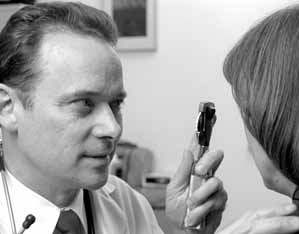 |
|
The Doctor is In.
by Sharon Butler When John Foxen was just a skinny kid living in a simple frame house in the hamlet of West Chicago, his family physician was Dr. David R. Morrison. Foxen remembers vividly an incident from his childhood. One of his fellow Little Leaguers, standing in the field behind him, threw a ball, and called out to him. Foxen turned , and caught the baseball straight in the eye. He was knocked out cold. The next thing he knew, Morrison was staring him in the face. Foxen was screaming at the top of his lungs when he came to, and the good doctor just looked down at him and calmly enquired. "Does something hurt? Why are you screaming?" Foxen thought for a second, realized he wasn't in pain, and promptly shut up. Little did Foxen know then that, some 40 years later, he would succeed Dr. Morrison as Fermilab's doctor-in-residence--officially, Director of Occupational Health. Foxen came on board this past January just as the Medical Office was transferred from the Laboratory Services Section to the Environment, Safety, and Health Section. That organizational change underscored the office's role in occupational health. An important mission of the medical office, Foxen explained, is "to function as an occupational health facility that finds ways to prevent injuries and make the workplace safer." That responsibility involves being actively involved in managing work-related injuries, and minimizing the need for long-term, complicated and costly treatment. The organizational switch to ES&H was "a logical and effective way to structure the organization," Foxen said, making the entire medical staff "teammates of the safety officers" and enabling them all to work more closely and provide still better service. The medical staff includes two nurses, Mae Strobel and Elaine Brown; a receptionist, Linda Hardamon; and an insurance administrator, Sharon Koteles. "Without them," Foxen said, "I couldn't do my job." In his first 10 months here at Fermilab, Foxen has already made some significant changes. For one, he's making "house calls." "Family doctors know how important it is to make house calls--you don't really know your patients until you visit them at home," said Foxen, whose training is in family medicine. Similarly, by visiting the industrial and experimental areas at Fermilab, Foxen believes he can help his patients here by seeing the environment in which they work. He visited one of Fermilab's clean rooms where workers in protective clothing handle epoxy resins that can cause rashes and even more severe allergic reactions. He visited the DZero experimental hall, the daycare center, and the area housing the Beams Division. (Out of curiosity, he also snuck a look at the old bubble chamber, no longer in use.) Foxen will soon be making a house call to CDF to help a worker suffering from tendinitis figure out which tasks he can do and which he can't to avoid aggravating his medical problem.
Foxen has also now customized and personalized the physical exams offered to Fermilab's 2,000-some employees as a benefit, making the exams more relevant to the individual while allowing Foxen the time he needs to devote to occupational health issues. Previously, employees received a slew of tests, regardless of whether there was any clinical reason to suspect a problem.
Above all, Foxen is eager to open communication between the medical staff and all members of Fermilab's community--workers and their supervisors--to protect everyone's safety and health, and to ensure that, when injuries do occur, people are treated promptly and effectively. He sends a message to all employees: yes, the doctor is in.
|
| last modified 12/3/1999 email Fermilab |
FRLsDFx9eyfrPXgV
 Besides making house calls, Foxen has also streamlined certain medical practices. For example, workers used to undergo a time-consuming series of medical tests to obtain approval for entering areas of the accelerator tunnel declared potentially hazardous because of oxygen deficiency. Foxen now does a brief history and a brief physical exam, requiring the tests (e.g., an EKG) only if needed. Approval can take as little as 10 minutes, depending on the worker's physical condition. With the accelerator complex turned on in stages this year, and areas sometimes declared "ODH" overnight, the streamlining of the medical approval procedure made a real difference--while still fully protecting workers.
Besides making house calls, Foxen has also streamlined certain medical practices. For example, workers used to undergo a time-consuming series of medical tests to obtain approval for entering areas of the accelerator tunnel declared potentially hazardous because of oxygen deficiency. Foxen now does a brief history and a brief physical exam, requiring the tests (e.g., an EKG) only if needed. Approval can take as little as 10 minutes, depending on the worker's physical condition. With the accelerator complex turned on in stages this year, and areas sometimes declared "ODH" overnight, the streamlining of the medical approval procedure made a real difference--while still fully protecting workers.